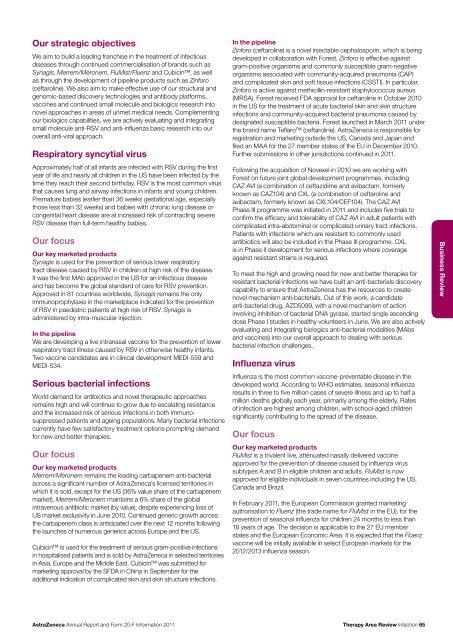AstraZeneca Annual Report and Form 20-F Information 2011
AstraZeneca Annual Report and Form 20-F Information 2011
AstraZeneca Annual Report and Form 20-F Information 2011
- No tags were found...
You also want an ePaper? Increase the reach of your titles
YUMPU automatically turns print PDFs into web optimized ePapers that Google loves.
Our strategic objectivesWe aim to build a leading franchise in the treatment of infectiousdiseases through continued commercialisation of br<strong>and</strong>s such asSynagis, Merrem/Meronem, FluMist/Fluenz <strong>and</strong> Cubicin, as wellas through the development of pipeline products such as Zinforo(ceftaroline). We also aim to make effective use of our structural <strong>and</strong>genomic-based discovery technologies <strong>and</strong> antibody platforms,vaccines <strong>and</strong> continued small molecule <strong>and</strong> biologics research intonovel approaches in areas of unmet medical needs. Complementingour biologics capabilities, we are actively evaluating <strong>and</strong> integratingsmall molecule anti-RSV <strong>and</strong> anti-influenza basic research into ouroverall anti-viral approach.Respiratory syncytial virusApproximately half of all infants are infected with RSV during the firstyear of life <strong>and</strong> nearly all children in the US have been infected by thetime they reach their second birthday. RSV is the most common virusthat causes lung <strong>and</strong> airway infections in infants <strong>and</strong> young children.Premature babies (earlier than 36 weeks gestational age, especiallythose less than 32 weeks) <strong>and</strong> babies with chronic lung disease orcongenital heart disease are at increased risk of contracting severeRSV disease than full-term healthy babies.Our focusOur key marketed productsSynagis is used for the prevention of serious lower respiratorytract disease caused by RSV in children at high risk of the disease.It was the first MAb approved in the US for an infectious disease<strong>and</strong> has become the global st<strong>and</strong>ard of care for RSV prevention.Approved in 81 countries worldwide, Synagis remains the onlyimmunoprophylaxis in the marketplace indicated for the preventionof RSV in paediatric patients at high risk of RSV. Synagis isadministered by intra-muscular injection.In the pipelineWe are developing a live intranasal vaccine for the prevention of lowerrespiratory tract illness caused by RSV in otherwise healthy infants.Two vaccine c<strong>and</strong>idates are in clinical development MEDI-559 <strong>and</strong>MEDI-534.Serious bacterial infectionsWorld dem<strong>and</strong> for antibiotics <strong>and</strong> novel therapeutic approachesremains high <strong>and</strong> will continue to grow due to escalating resistance<strong>and</strong> the increased risk of serious infections in both immunosuppressedpatients <strong>and</strong> ageing populations. Many bacterial infectionscurrently have few satisfactory treatment options prompting dem<strong>and</strong>for new <strong>and</strong> better therapies.Our focusOur key marketed productsMerrem/Meronem remains the leading carbapenem anti-bacterialacross a significant number of <strong>AstraZeneca</strong>’s licensed territories inwhich it is sold, except for the US (36% value share of the carbapenemmarket). Merrem/Meronem maintains a 6% share of the globalintravenous antibiotic market (by value), despite experiencing loss ofUS market exclusivity in June <strong>20</strong>10. Continued generic growth acrossthe carbapenem class is anticipated over the next 12 months followingthe launches of numerous generics across Europe <strong>and</strong> the US.Cubicin is used for the treatment of serious gram-positive infectionsin hospitalised patients <strong>and</strong> is sold by <strong>AstraZeneca</strong> in selected territoriesin Asia, Europe <strong>and</strong> the Middle East. Cubicin was submitted formarketing approval by the SFDA in China in September for theadditional indication of complicated skin <strong>and</strong> skin structure infections.In the pipelineZinforo (ceftaroline) is a novel injectable cephalosporin, which is beingdeveloped in collaboration with Forest. Zinforo is effective againstgram-positive organisms <strong>and</strong> commonly susceptible gram-negativeorganisms associated with community-acquired pneumonia (CAP)<strong>and</strong> complicated skin <strong>and</strong> soft tissue infections (CSSTI). In particular,Zinforo is active against methicillin-resistant staphylococcus aureus(MRSA). Forest received FDA approval for ceftaroline in October <strong>20</strong>10in the US for the treatment of acute bacterial skin <strong>and</strong> skin structureinfections <strong>and</strong> community-acquired bacterial pneumonia caused bydesignated susceptible bacteria. Forest launched in March <strong>20</strong>11 underthe br<strong>and</strong> name Teflaro (ceftaroline). <strong>AstraZeneca</strong> is responsible forregistration <strong>and</strong> marketing outside the US, Canada <strong>and</strong> Japan <strong>and</strong>filed an MAA for the 27 member states of the EU in December <strong>20</strong>10.Further submissions in other jurisdictions continued in <strong>20</strong>11.Following the acquisition of Novexel in <strong>20</strong>10 we are working withForest on future joint global development programmes, includingCAZ AVI (a combination of ceftazidime <strong>and</strong> avibactam, formerlyknown as CAZ104) <strong>and</strong> CXL (a combination of ceftaroline <strong>and</strong>avibactam, formerly known as CXL104/CEF104). The CAZ AVIPhase III programme was initiated in <strong>20</strong>11 <strong>and</strong> includes five trials toconfirm the efficacy <strong>and</strong> tolerability of CAZ AVI in adult patients withcomplicated intra-abdominal or complicated urinary tract infections.Patients with infections which are resistant to commonly usedantibiotics will also be included in the Phase III programme. CXLis in Phase II development for serious infections where coverageagainst resistant strains is required.To meet the high <strong>and</strong> growing need for new <strong>and</strong> better therapies forresistant bacterial infections we have built an anti-bacterials discoverycapability to ensure that <strong>AstraZeneca</strong> has the resources to createnovel mechanism anti-bacterials. Out of this work, a c<strong>and</strong>idateanti-bacterial drug, AZD5099, with a novel mechanism of actioninvolving inhibition of bacterial DNA gyrase, started single ascendingdose Phase I studies in healthy volunteers in June. We are also activelyevaluating <strong>and</strong> integrating biologics anti-bacterial modalities (MAbs<strong>and</strong> vaccines) into our overall approach to dealing with seriousbacterial infection challenges.Influenza virusInfluenza is the most common vaccine-preventable disease in thedeveloped world. According to WHO estimates, seasonal influenzaresults in three to five million cases of severe illness <strong>and</strong> up to half amillion deaths globally each year, primarily among the elderly. Ratesof infection are highest among children, with school-aged childrensignificantly contributing to the spread of the disease.Our focusOur key marketed productsFluMist is a trivalent live, attenuated nasally delivered vaccineapproved for the prevention of disease caused by influenza virussubtypes A <strong>and</strong> B in eligible children <strong>and</strong> adults. FluMist is nowapproved for eligible individuals in seven countries including the US,Canada <strong>and</strong> Brazil.In February <strong>20</strong>11, the European Commission granted marketingauthorisation to Fluenz (the trade name for FluMist in the EU), for theprevention of seasonal influenza for children 24 months to less than18 years of age. The decision is applicable to the 27 EU memberstates <strong>and</strong> the European Economic Area. It is expected that the Fluenzvaccine will be initially available in select European markets for the<strong>20</strong>12/<strong>20</strong>13 influenza season.Business Review<strong>AstraZeneca</strong> <strong>Annual</strong> <strong>Report</strong> <strong>and</strong> <strong>Form</strong> <strong>20</strong>-F <strong>Information</strong> <strong>20</strong>11Therapy Area Review Infection 65










